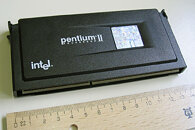- Joined
- Oct 9, 2007
- Messages
- 47,233 (7.55/day)
- Location
- Hyderabad, India
| System Name | RBMK-1000 |
|---|---|
| Processor | AMD Ryzen 7 5700G |
| Motherboard | ASUS ROG Strix B450-E Gaming |
| Cooling | DeepCool Gammax L240 V2 |
| Memory | 2x 8GB G.Skill Sniper X |
| Video Card(s) | Palit GeForce RTX 2080 SUPER GameRock |
| Storage | Western Digital Black NVMe 512GB |
| Display(s) | BenQ 1440p 60 Hz 27-inch |
| Case | Corsair Carbide 100R |
| Audio Device(s) | ASUS SupremeFX S1220A |
| Power Supply | Cooler Master MWE Gold 650W |
| Mouse | ASUS ROG Strix Impact |
| Keyboard | Gamdias Hermes E2 |
| Software | Windows 11 Pro |
Back in the glory days of x86 in the 1990s, you could buy an IBM PC-compatible x86 processor from not just Intel and AMD, but also the likes of Cyrix, IDT, Transmeta, and NEC. Competition among the various x86 licensees propelled innovation through the first half of the 32-bit era, but toward the end of the century, and with the Y2K frenzy looming, the PC processor market saw a slew of consolidations, such as Cyrix and IDT (later Centaur) being acquired by VIA Technology. As of 2000, only two companies made high performance x86 processors, and processors for servers—Intel and AMD, with VIA Technology limiting itself to the entry-level PC market. Then came along Arm Cortex 32-bit, graduating from the embedded computing market to client computing, driven by smartphones.
Intel's main competitor today isn't AMD, it's Arm and its constellation of licensees, such as Apple, Qualcomm, Samsung, MediaTek, and NVIDIA. Over the decades that followed the advent of the iPhone, Arm graduated from smartphones to PCs (eg: Snapdragon X, Apple M3), and servers (eg: Ampere Altra and NVIDIA Grace). Intel seems to have had the sudden realization that Intel Products should open up in the same way as Intel Foundry Services, and that just as IFS in Pat Gelsinger's words aspires to be the "TSMC of America," x86 should aspire to be the "Arm of America." The only way to go about doing this is to adopt an IP licensing model similar to that of Arm, where third parties are licensed the x86 machine architecture, and should pay Intel royalties based on their chip volumes, and other factors such as CPU core counts. Much like Arm, Intel could set up separate licensing models for SoC designers who want Intel's various IA cores as IP blocks, or just the x86 license to design their own cores, like AMD does. Since Intel is a founding member of the UCIe alliance, it could even offer up Compute tiles as chiplets.

We're not sure how Intel traverses the web of cross-licensing with AMD behind x86-64; the company probably has a separate agreement with Sunnyvale that gives it a portion of the royalties. The opening up of x86 should have a profound impact on the computing industry, and bring big-ticket players such as NVIDIA, Samsung, and Qualcomm to design better x86 cores than Intel and AMD, and perhaps even figure out how to bring x86 to the performance/Watt levels of competing Arm cores. We expect the first contemporary non-Intel, non-AMD x86 processors to start selling by April 1, 2026.
View at TechPowerUp Main Site
Intel's main competitor today isn't AMD, it's Arm and its constellation of licensees, such as Apple, Qualcomm, Samsung, MediaTek, and NVIDIA. Over the decades that followed the advent of the iPhone, Arm graduated from smartphones to PCs (eg: Snapdragon X, Apple M3), and servers (eg: Ampere Altra and NVIDIA Grace). Intel seems to have had the sudden realization that Intel Products should open up in the same way as Intel Foundry Services, and that just as IFS in Pat Gelsinger's words aspires to be the "TSMC of America," x86 should aspire to be the "Arm of America." The only way to go about doing this is to adopt an IP licensing model similar to that of Arm, where third parties are licensed the x86 machine architecture, and should pay Intel royalties based on their chip volumes, and other factors such as CPU core counts. Much like Arm, Intel could set up separate licensing models for SoC designers who want Intel's various IA cores as IP blocks, or just the x86 license to design their own cores, like AMD does. Since Intel is a founding member of the UCIe alliance, it could even offer up Compute tiles as chiplets.

We're not sure how Intel traverses the web of cross-licensing with AMD behind x86-64; the company probably has a separate agreement with Sunnyvale that gives it a portion of the royalties. The opening up of x86 should have a profound impact on the computing industry, and bring big-ticket players such as NVIDIA, Samsung, and Qualcomm to design better x86 cores than Intel and AMD, and perhaps even figure out how to bring x86 to the performance/Watt levels of competing Arm cores. We expect the first contemporary non-Intel, non-AMD x86 processors to start selling by April 1, 2026.
View at TechPowerUp Main Site









